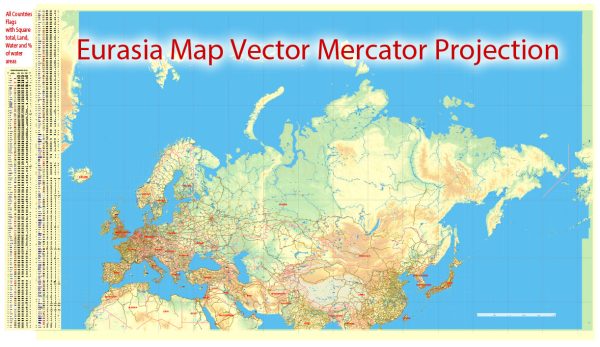The road systems in Europe and Asia have evolved over thousands of years, shaped by historical, cultural, economic, and technological factors. A brief overview of key developments in each region.
Vectormap.Net provide you with the most accurate and up-to-date vector maps in Adobe Illustrator, PDF and other formats, designed for editing and printing. Please read the vector map descriptions carefully.
Europe:
- Ancient Roman Roads (circa 500 BC – 476 AD): The Romans were pioneers in road construction. They built an extensive network of roads connecting different parts of the Roman Empire, facilitating trade, military movements, and cultural exchange.
- Medieval Trade Routes (circa 476 – 1453 AD): During the Middle Ages, trade routes like the Silk Road and Amber Road connected Europe with Asia. Roads played a crucial role in the economic development of various regions.
- Post-Roman and Medieval Periods (circa 476 – 1500s AD): With the decline of the Roman Empire, many Roman roads fell into disrepair. Local lords and monarchs maintained some routes, but overall road infrastructure suffered.
- Renaissance and Early Modern Era (15th – 18th centuries): As trade and commerce revived during the Renaissance, there was a renewed interest in improving roads. Governments and local authorities started investing in road infrastructure to boost economic activities.
- Industrial Revolution (18th – 19th centuries): The advent of the Industrial Revolution led to significant improvements in road construction techniques. Canals and railways became dominant modes of transport, but roads were still crucial for connecting rural areas.
- 20th Century: The automobile revolutionized transportation. European countries invested heavily in road infrastructure during the 20th century. Organizations like the European Union have also played a role in coordinating transnational road networks.
- 21st Century: Modern European road systems are well-developed, with high-speed highways, tunnels, and bridges connecting cities and regions. Sustainable and smart transportation technologies are increasingly integrated into road systems.
Asia:
- Silk Road and Ancient Trade Routes (circa 2nd century BC – 14th century AD): The Silk Road was a vast network of trade routes connecting Asia with the Mediterranean. It facilitated cultural exchange and economic activities along its overland and maritime routes.
- Persian Royal Roads (circa 550 – 330 BC): The Achaemenid Empire in Persia established a network of well-maintained roads, known as the Royal Roads, which played a key role in communication and administration.
- Mughal Roads (16th – 18th centuries): The Mughal Empire in South Asia developed an extensive road network to facilitate trade and administration. The Grand Trunk Road, built during this period, remains a significant historical route.
- Colonial Period (19th – mid-20th centuries): European colonial powers often improved or expanded road infrastructure in their colonies for economic exploitation and administrative control.
- Post-Independence Era: Many Asian countries focused on developing their road systems after gaining independence. Rapid industrialization and urbanization in the 20th century drove the need for efficient transportation networks.
- 21st Century: Asian countries have seen substantial investments in modern road infrastructure, with a focus on high-speed highways, expressways, and bridges. China’s Belt and Road Initiative is a contemporary example of a large-scale effort to improve cross-border connectivity.
Both Europe and Asia continue to invest in and adapt their road systems to meet the evolving needs of society, trade, and transportation. The histories of these road systems reflect the broader historical, cultural, and economic contexts of their respective regions.


 Author: Kirill Shrayber, Ph.D.
Author: Kirill Shrayber, Ph.D.